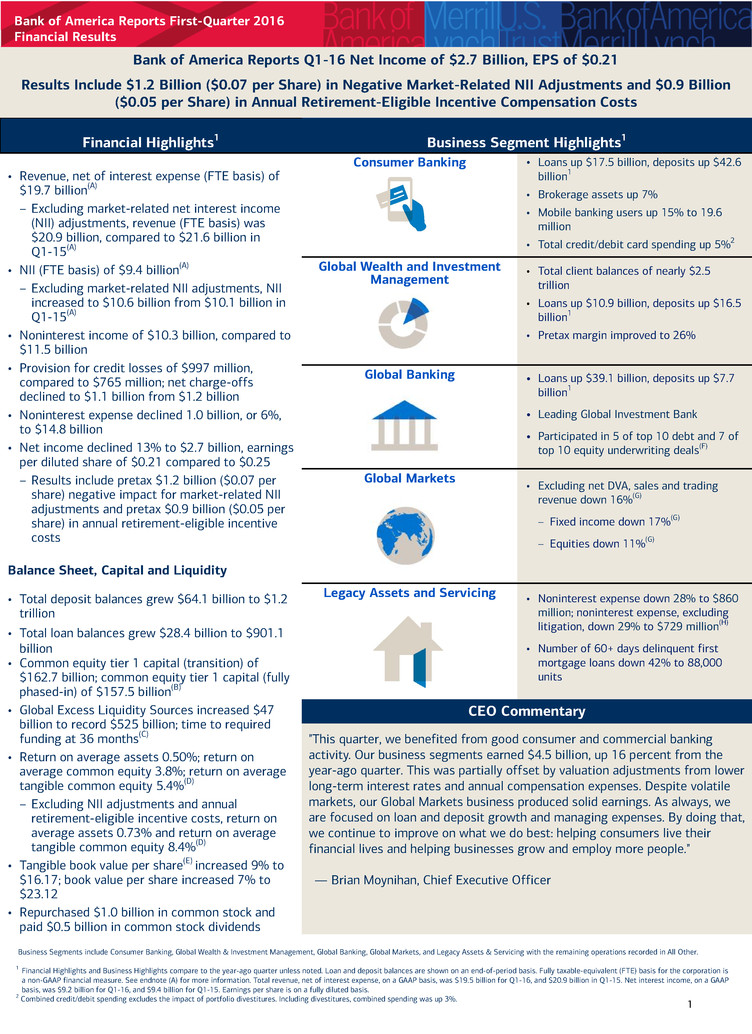
Bank of America Reports First-Quarter 2016 Financial Results 1 Financial Highlights1 Business Segment Highlights1 Consumer Banking Global Wealth and Investment Management Global Banking Global Markets Legacy Assets and Servicing CEO Commentary Business Segments include Consumer Banking, Global Wealth & Investment Management, Global Banking, Global Markets, and Legacy Assets & Servicing with the remaining operations recorded in All Other. 1 Financial Highlights and Business Highlights compare to the year-ago quarter unless noted. Loan and deposit balances are shown on an end-of-period basis. Fully taxable-equivalent (FTE) basis for the corporation is a non-GAAP financial measure. See endnote (A) for more information. Total revenue, net of interest expense, on a GAAP basis, was $19.5 billion for Q1-16, and $20.9 billion in Q1-15. Net interest income, on a GAAP basis, was $9.2 billion for Q1-16, and $9.4 billion for Q1-15. Earnings per share is on a fully diluted basis. 2 Combined credit/debit spending excludes the impact of portfolio divestitures. Including divestitures, combined spending was up 3%. • Loans up $17.5 billion, deposits up $42.6 billion1 • Brokerage assets up 7% • Mobile banking users up 15% to 19.6 million • Total credit/debit card spending up 5%2 • Revenue, net of interest expense (FTE basis) of $19.7 billion(A) – Excluding market-related net interest income (NII) adjustments, revenue (FTE basis) was $20.9 billion, compared to $21.6 billion in Q1-15(A) • NII (FTE basis) of $9.4 billion(A) – Excluding market-related NII adjustments, NII increased to $10.6 billion from $10.1 billion in Q1-15(A) • Noninterest income of $10.3 billion, compared to $11.5 billion • Provision for credit losses of $997 million, compared to $765 million; net charge-offs declined to $1.1 billion from $1.2 billion • Noninterest expense declined 1.0 billion, or 6%, to $14.8 billion • Net income declined 13% to $2.7 billion, earnings per diluted share of $0.21 compared to $0.25 – Results include pretax $1.2 billion ($0.07 per share) negative impact for market-related NII adjustments and pretax $0.9 billion ($0.05 per share) in annual retirement-eligible incentive costs Balance Sheet, Capital and Liquidity • Total deposit balances grew $64.1 billion to $1.2 trillion • Total loan balances grew $28.4 billion to $901.1 billion • Common equity tier 1 capital (transition) of $162.7 billion; common equity tier 1 capital (fully phased-in) of $157.5 billion(B) • Global Excess Liquidity Sources increased $47 billion to record $525 billion; time to required funding at 36 months(C) • Return on average assets 0.50%; return on average common equity 3.8%; return on average tangible common equity 5.4%(D) – Excluding NII adjustments and annual retirement-eligible incentive costs, return on average assets 0.73% and return on average tangible common equity 8.4%(D) • Tangible book value per share(E) increased 9% to $16.17; book value per share increased 7% to $23.12 • Repurchased $1.0 billion in common stock and paid $0.5 billion in common stock dividends • Total client balances of nearly $2.5 trillion • Loans up $10.9 billion, deposits up $16.5 billion1 • Pretax margin improved to 26% • Loans up $39.1 billion, deposits up $7.7 billion1 • Leading Global Investment Bank • Participated in 5 of top 10 debt and 7 of top 10 equity underwriting deals(F) • Excluding net DVA, sales and trading revenue down 16%(G) – Fixed income down 17%(G) – Equities down 11%(G) • Noninterest expense down 28% to $860 million; noninterest expense, excluding litigation, down 29% to $729 million(H) • Number of 60+ days delinquent first mortgage loans down 42% to 88,000 units Bank of America Reports Q1-16 Net Income of $2.7 Billion, EPS of $0.21 Results Include $1.2 Billion ($0.07 per Share) in Negative Market-Related NII Adjustments and $0.9 Billion ($0.05 per Share) in Annual Retirement-Eligible Incentive Compensation Costs "This quarter, we benefited from good consumer and commercial banking activity. Our business segments earned $4.5 billion, up 16 percent from the year-ago quarter. This was partially offset by valuation adjustments from lower long-term interest rates and annual compensation expenses. Despite volatile markets, our Global Markets business produced solid earnings. As always, we are focused on loan and deposit growth and managing expenses. By doing that, we continue to improve on what we do best: helping consumers live their financial lives and helping businesses grow and employ more people." — Brian Moynihan, Chief Executive Officer
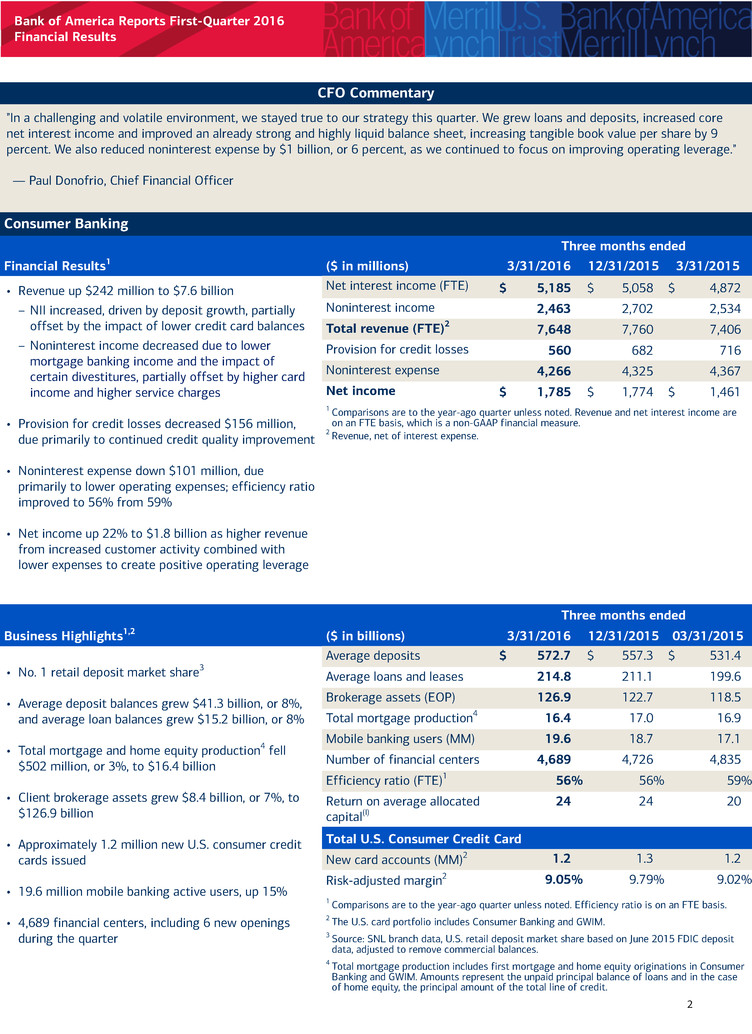
Bank of America Reports First-Quarter 2016 Financial Results 2 CFO Commentary Consumer Banking Three months ended Financial Results1 ($ in millions) 3/31/2016 12/31/2015 3/31/2015 Net interest income (FTE) $ 5,185 $ 5,058 $ 4,872 Noninterest income 2,463 2,702 2,534 Total revenue (FTE)2 7,648 7,760 7,406 Provision for credit losses 560 682 716 Noninterest expense 4,266 4,325 4,367 Net income $ 1,785 $ 1,774 $ 1,461 1 Comparisons are to the year-ago quarter unless noted. Revenue and net interest income are on an FTE basis, which is a non-GAAP financial measure. 2 Revenue, net of interest expense. Three months ended Business Highlights1,2 ($ in billions) 3/31/2016 12/31/2015 03/31/2015 Average deposits $ 572.7 $ 557.3 $ 531.4 Average loans and leases 214.8 211.1 199.6 Brokerage assets (EOP) 126.9 122.7 118.5 Total mortgage production4 16.4 17.0 16.9 Mobile banking users (MM) 19.6 18.7 17.1 Number of financial centers 4,689 4,726 4,835 Efficiency ratio (FTE)1 56% 56% 59% Return on average allocated capital(I) 24 24 20 Total U.S. Consumer Credit Card New card accounts (MM)2 1.2 1.3 1.2 Risk-adjusted margin2 9.05% 9.79% 9.02% 1 Comparisons are to the year-ago quarter unless noted. Efficiency ratio is on an FTE basis. 2 The U.S. card portfolio includes Consumer Banking and GWIM. 3 Source: SNL branch data, U.S. retail deposit market share based on June 2015 FDIC deposit data, adjusted to remove commercial balances. 4 Total mortgage production includes first mortgage and home equity originations in Consumer Banking and GWIM. Amounts represent the unpaid principal balance of loans and in the case of home equity, the principal amount of the total line of credit. "In a challenging and volatile environment, we stayed true to our strategy this quarter. We grew loans and deposits, increased core net interest income and improved an already strong and highly liquid balance sheet, increasing tangible book value per share by 9 percent. We also reduced noninterest expense by $1 billion, or 6 percent, as we continued to focus on improving operating leverage." — Paul Donofrio, Chief Financial Officer • Revenue up $242 million to $7.6 billion – NII increased, driven by deposit growth, partially offset by the impact of lower credit card balances – Noninterest income decreased due to lower mortgage banking income and the impact of certain divestitures, partially offset by higher card income and higher service charges • Provision for credit losses decreased $156 million, due primarily to continued credit quality improvement • Noninterest expense down $101 million, due primarily to lower operating expenses; efficiency ratio improved to 56% from 59% • Net income up 22% to $1.8 billion as higher revenue from increased customer activity combined with lower expenses to create positive operating leverage • No. 1 retail deposit market share3 • Average deposit balances grew $41.3 billion, or 8%, and average loan balances grew $15.2 billion, or 8% • Total mortgage and home equity production4 fell $502 million, or 3%, to $16.4 billion • Client brokerage assets grew $8.4 billion, or 7%, to $126.9 billion • Approximately 1.2 million new U.S. consumer credit cards issued • 19.6 million mobile banking active users, up 15% • 4,689 financial centers, including 6 new openings during the quarter
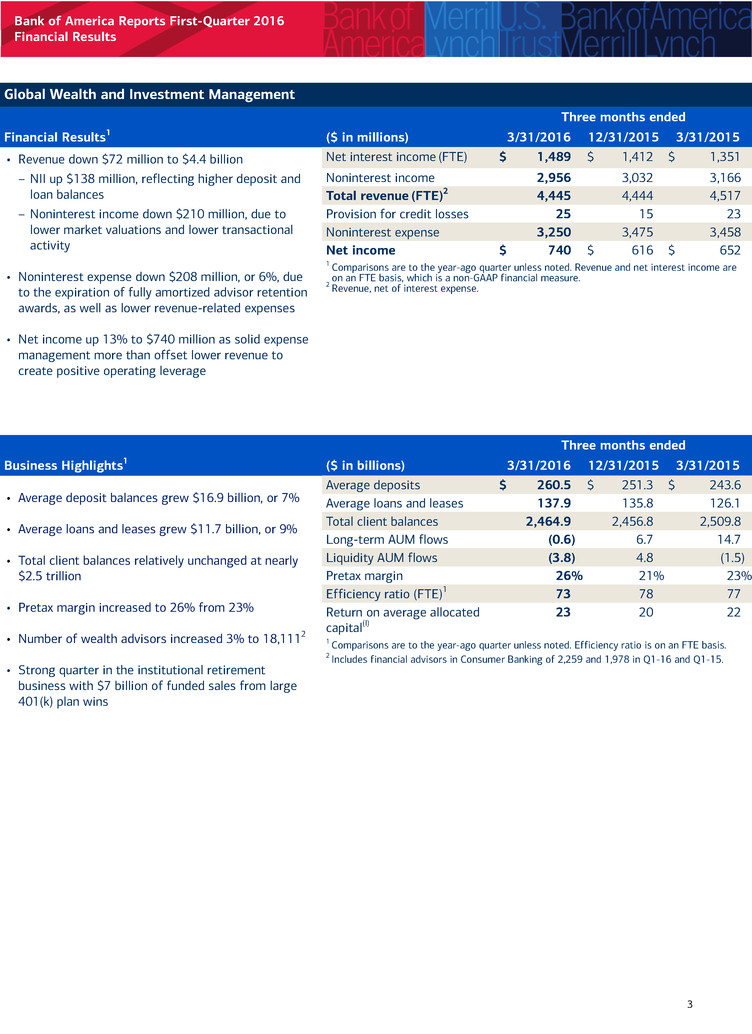
Bank of America Reports First-Quarter 2016 Financial Results 3 Global Wealth and Investment Management Three months ended Financial Results1 ($ in millions) 3/31/2016 12/31/2015 3/31/2015 Net interest income (FTE) $ 1,489 $ 1,412 $ 1,351 Noninterest income 2,956 3,032 3,166 Total revenue (FTE)2 4,445 4,444 4,517 Provision for credit losses 25 15 23 Noninterest expense 3,250 3,475 3,458 Net income $ 740 $ 616 $ 652 1 Comparisons are to the year-ago quarter unless noted. Revenue and net interest income are on an FTE basis, which is a non-GAAP financial measure. 2 Revenue, net of interest expense. Three months ended Business Highlights1 ($ in billions) 3/31/2016 12/31/2015 3/31/2015 Average deposits $ 260.5 $ 251.3 $ 243.6 Average loans and leases 137.9 135.8 126.1 Total client balances 2,464.9 2,456.8 2,509.8 Long-term AUM flows (0.6) 6.7 14.7 Liquidity AUM flows (3.8) 4.8 (1.5) Pretax margin 26% 21% 23% Efficiency ratio (FTE)1 73 78 77 Return on average allocated capital(I) 23 20 22 1 Comparisons are to the year-ago quarter unless noted. Efficiency ratio is on an FTE basis. 2 Includes financial advisors in Consumer Banking of 2,259 and 1,978 in Q1-16 and Q1-15. • Revenue down $72 million to $4.4 billion – NII up $138 million, reflecting higher deposit and loan balances – Noninterest income down $210 million, due to lower market valuations and lower transactional activity • Noninterest expense down $208 million, or 6%, due to the expiration of fully amortized advisor retention awards, as well as lower revenue-related expenses • Net income up 13% to $740 million as solid expense management more than offset lower revenue to create positive operating leverage • Average deposit balances grew $16.9 billion, or 7% • Average loans and leases grew $11.7 billion, or 9% • Total client balances relatively unchanged at nearly $2.5 trillion • Pretax margin increased to 26% from 23% • Number of wealth advisors increased 3% to 18,1112 • Strong quarter in the institutional retirement business with $7 billion of funded sales from large 401(k) plan wins
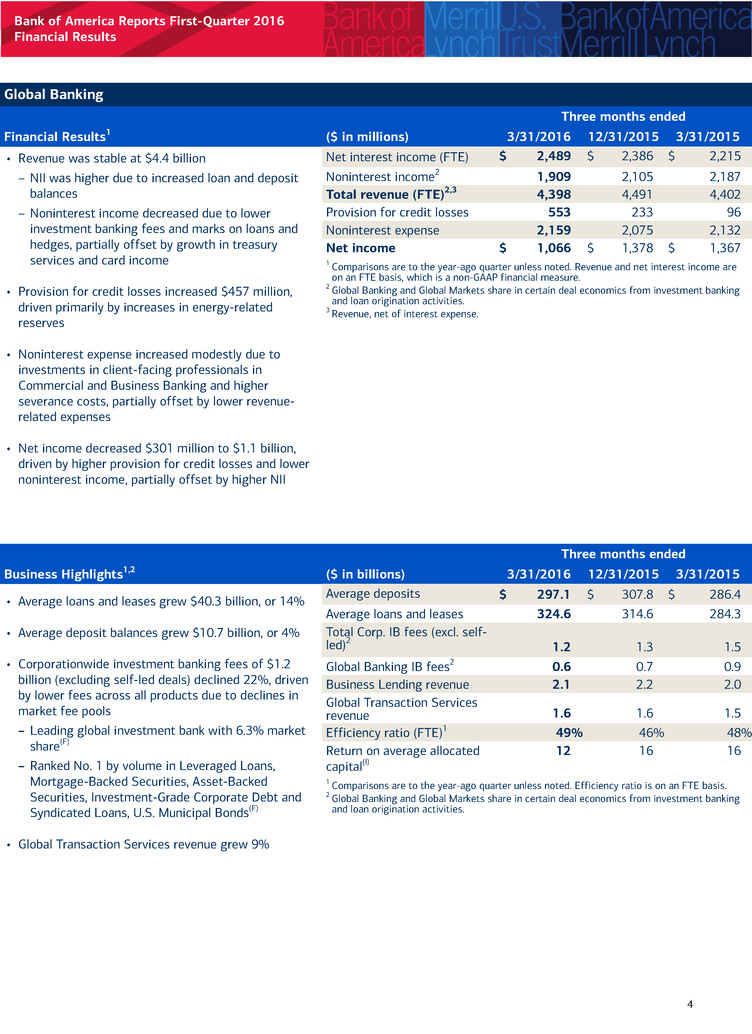
Bank of America Reports First-Quarter 2016 Financial Results 4 Global Banking Three months ended Financial Results1 ($ in millions) 3/31/2016 12/31/2015 3/31/2015 Net interest income (FTE) $ 2,489 $ 2,386 $ 2,215 Noninterest income2 1,909 2,105 2,187 Total revenue (FTE)2,3 4,398 4,491 4,402 Provision for credit losses 553 233 96 Noninterest expense 2,159 2,075 2,132 Net income $ 1,066 $ 1,378 $ 1,367 1 Comparisons are to the year-ago quarter unless noted. Revenue and net interest income are on an FTE basis, which is a non-GAAP financial measure. 2 Global Banking and Global Markets share in certain deal economics from investment banking and loan origination activities. 3 Revenue, net of interest expense. Three months ended Business Highlights1,2 ($ in billions) 3/31/2016 12/31/2015 3/31/2015 Average deposits $ 297.1 $ 307.8 $ 286.4 Average loans and leases 324.6 314.6 284.3 Total Corp. IB fees (excl. self- led)2 1.2 1.3 1.5 Global Banking IB fees2 0.6 0.7 0.9 Business Lending revenue 2.1 2.2 2.0 Global Transaction Services revenue 1.6 1.6 1.5 Efficiency ratio (FTE)1 49% 46% 48% Return on average allocated capital(I) 12 16 16 1 Comparisons are to the year-ago quarter unless noted. Efficiency ratio is on an FTE basis. 2 Global Banking and Global Markets share in certain deal economics from investment banking and loan origination activities. • Revenue was stable at $4.4 billion – NII was higher due to increased loan and deposit balances – Noninterest income decreased due to lower investment banking fees and marks on loans and hedges, partially offset by growth in treasury services and card income • Provision for credit losses increased $457 million, driven primarily by increases in energy-related reserves • Noninterest expense increased modestly due to investments in client-facing professionals in Commercial and Business Banking and higher severance costs, partially offset by lower revenue- related expenses • Net income decreased $301 million to $1.1 billion, driven by higher provision for credit losses and lower noninterest income, partially offset by higher NII • Average loans and leases grew $40.3 billion, or 14% • Average deposit balances grew $10.7 billion, or 4% • Corporationwide investment banking fees of $1.2 billion (excluding self-led deals) declined 22%, driven by lower fees across all products due to declines in market fee pools – Leading global investment bank with 6.3% market share(F) – Ranked No. 1 by volume in Leveraged Loans, Mortgage-Backed Securities, Asset-Backed Securities, Investment-Grade Corporate Debt and Syndicated Loans, U.S. Municipal Bonds(F) • Global Transaction Services revenue grew 9%
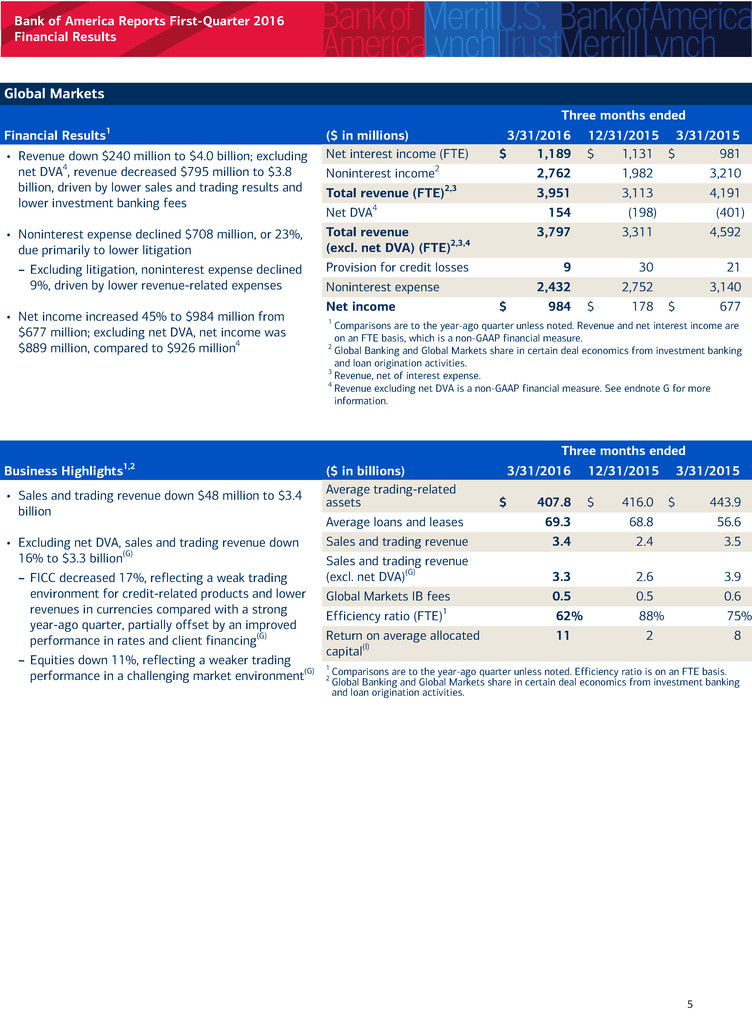
Bank of America Reports First-Quarter 2016 Financial Results 5 Global Markets Three months ended Financial Results1 ($ in millions) 3/31/2016 12/31/2015 3/31/2015 Net interest income (FTE) $ 1,189 $ 1,131 $ 981 Noninterest income2 2,762 1,982 3,210 Total revenue (FTE)2,3 3,951 3,113 4,191 Net DVA4 154 (198) (401) Total revenue (excl. net DVA) (FTE)2,3,4 3,797 3,311 4,592 Provision for credit losses 9 30 21 Noninterest expense 2,432 2,752 3,140 Net income $ 984 $ 178 $ 677 Three months ended Business Highlights1,2 ($ in billions) 3/31/2016 12/31/2015 3/31/2015 Average trading-related assets $ 407.8 $ 416.0 $ 443.9 Average loans and leases 69.3 68.8 56.6 Sales and trading revenue 3.4 2.4 3.5 Sales and trading revenue (excl. net DVA)(G) 3.3 2.6 3.9 Global Markets IB fees 0.5 0.5 0.6 Efficiency ratio (FTE)1 62% 88% 75% Return on average allocated capital(I) 11 2 8 1 Comparisons are to the year-ago quarter unless noted. Efficiency ratio is on an FTE basis. 2 Global Banking and Global Markets share in certain deal economics from investment banking and loan origination activities. • Revenue down $240 million to $4.0 billion; excluding net DVA4, revenue decreased $795 million to $3.8 billion, driven by lower sales and trading results and lower investment banking fees • Noninterest expense declined $708 million, or 23%, due primarily to lower litigation – Excluding litigation, noninterest expense declined 9%, driven by lower revenue-related expenses • Net income increased 45% to $984 million from $677 million; excluding net DVA, net income was $889 million, compared to $926 million4 • Sales and trading revenue down $48 million to $3.4 billion • Excluding net DVA, sales and trading revenue down 16% to $3.3 billion(G) – FICC decreased 17%, reflecting a weak trading environment for credit-related products and lower revenues in currencies compared with a strong year-ago quarter, partially offset by an improved performance in rates and client financing(G) – Equities down 11%, reflecting a weaker trading performance in a challenging market environment(G) 1 Comparisons are to the year-ago quarter unless noted. Revenue and net interest income are on an FTE basis, which is a non-GAAP financial measure. 2 Global Banking and Global Markets share in certain deal economics from investment banking and loan origination activities. 3 Revenue, net of interest expense. 4 Revenue excluding net DVA is a non-GAAP financial measure. See endnote G for more information.
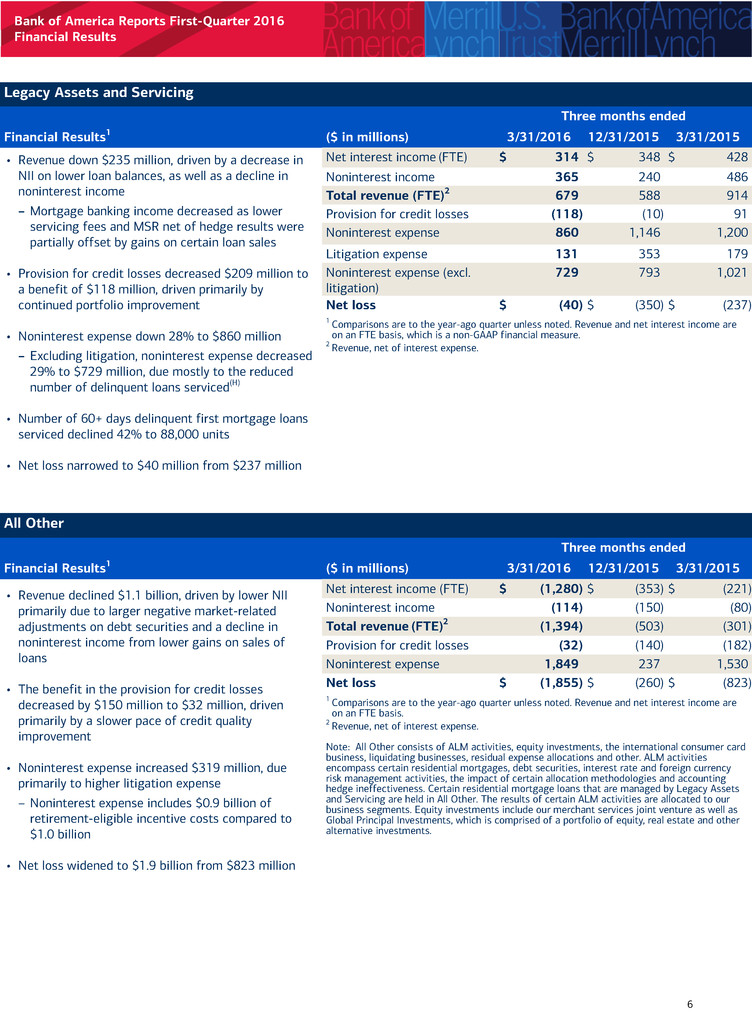
Bank of America Reports First-Quarter 2016 Financial Results 6 Legacy Assets and Servicing Three months ended Financial Results1 ($ in millions) 3/31/2016 12/31/2015 3/31/2015 Net interest income (FTE) $ 314 $ 348 $ 428 Noninterest income 365 240 486 Total revenue (FTE)2 679 588 914 Provision for credit losses (118) (10) 91 Noninterest expense 860 1,146 1,200 Litigation expense 131 353 179 Noninterest expense (excl. litigation) 729 793 1,021 Net loss $ (40) $ (350) $ (237) 1 Comparisons are to the year-ago quarter unless noted. Revenue and net interest income are on an FTE basis, which is a non-GAAP financial measure. 2 Revenue, net of interest expense. All Other Three months ended Financial Results1 ($ in millions) 3/31/2016 12/31/2015 3/31/2015 Net interest income (FTE) $ (1,280) $ (353) $ (221) Noninterest income (114) (150) (80) Total revenue (FTE)2 (1,394) (503) (301) Provision for credit losses (32) (140) (182) Noninterest expense 1,849 237 1,530 Net loss $ (1,855) $ (260) $ (823) 1 Comparisons are to the year-ago quarter unless noted. Revenue and net interest income are on an FTE basis. 2 Revenue, net of interest expense. Note: All Other consists of ALM activities, equity investments, the international consumer card business, liquidating businesses, residual expense allocations and other. ALM activities encompass certain residential mortgages, debt securities, interest rate and foreign currency risk management activities, the impact of certain allocation methodologies and accounting hedge ineffectiveness. Certain residential mortgage loans that are managed by Legacy Assets and Servicing are held in All Other. The results of certain ALM activities are allocated to our business segments. Equity investments include our merchant services joint venture as well as Global Principal Investments, which is comprised of a portfolio of equity, real estate and other alternative investments. • Revenue down $235 million, driven by a decrease in NII on lower loan balances, as well as a decline in noninterest income – Mortgage banking income decreased as lower servicing fees and MSR net of hedge results were partially offset by gains on certain loan sales • Provision for credit losses decreased $209 million to a benefit of $118 million, driven primarily by continued portfolio improvement • Noninterest expense down 28% to $860 million – Excluding litigation, noninterest expense decreased 29% to $729 million, due mostly to the reduced number of delinquent loans serviced(H) • Number of 60+ days delinquent first mortgage loans serviced declined 42% to 88,000 units • Net loss narrowed to $40 million from $237 million • Revenue declined $1.1 billion, driven by lower NII primarily due to larger negative market-related adjustments on debt securities and a decline in noninterest income from lower gains on sales of loans • The benefit in the provision for credit losses decreased by $150 million to $32 million, driven primarily by a slower pace of credit quality improvement • Noninterest expense increased $319 million, due primarily to higher litigation expense – Noninterest expense includes $0.9 billion of retirement-eligible incentive costs compared to $1.0 billion • Net loss widened to $1.9 billion from $823 million

Bank of America Reports First-Quarter 2016 Financial Results 7 Credit Quality Three months ended Highlights1 ($ in millions) 3/31/2016 12/31/2015 3/31/2015 Provision for credit losses $ 997 $ 810 $ 765 Net charge-offs 1,068 1,144 1,194 Net charge-off ratio2 0.48% 0.52% 0.56% At period-end Nonperforming loans, leases and foreclosed properties $ 9,281 $ 9,836 $ 12,101 Nonperforming loans, leases and foreclosed properties ratio3 1.04% 1.10% 1.40% Allowance for loan and lease losses $ 12,069 $ 12,234 $ 13,676 Allowance for loan and lease losses ratio4 1.35% 1.37% 1.58% 1 Comparisons are to the year-ago quarter unless noted. 2 Net charge-off ratio is calculated as annualized net charge-offs divided by average outstanding loans and leases during the period. 3 Nonperforming loans, leases and foreclosed properties ratio is calculated as nonperforming loans, leases and foreclosed properties divided by outstanding loans, leases and foreclosed properties at the end of the period. 4 Allowance for loan and lease losses ratio is calculated as allowance for loan and lease losses divided by loans and leases outstanding at the end of the period. Note: Ratios do not include loans accounted for under the fair value option. • Overall credit quality remained strong; consumer portfolios continued to improve, and commercial portfolios remained stable except the energy sector • Net charge-offs declined to $1.1 billion from $1.2 billion – Excluding losses associated with the settlement with the U.S. Department of Justice and nonperforming loan sales, net charge-offs were $1.0 billion in both Q1-16 and the year-ago quarter • The net charge-off ratio decreased to 0.48% from 0.56%; excluding the items noted above, the net charge-off ratio was 0.46% in Q1-16, down from 0.47% • Provision for credit losses increased to $997 million, due to increased reserves in the commercial portfolio due to energy sector exposure • Net reserve release was $71 million, compared to $429 million, as reserve releases in consumer were mostly offset by increased commercial reserves • Reservable criticized commercial exposures increased to $18.6 billion from $15.9 billion in the prior quarter and $11.9 billion in Q1-15, primarily due to increases in the energy sector Energy Exposure • Utilized energy exposure of $21.8 billion decreased $0.3 billion from Q1-15 – Higher risk subsectors of Exploration & Production (E&P) and Oil Field Services (OFS) decreased $0.6 billion from Q4-15 and $0.3 billion from Q1-15 to $7.7 billion, representing less than 1% of total corporation loans – Energy reserves increased $525 million from Q4-15 to $1.0 billion, primarily driven by increased allowance coverage for the higher risk subsectors (E&P and OFS)
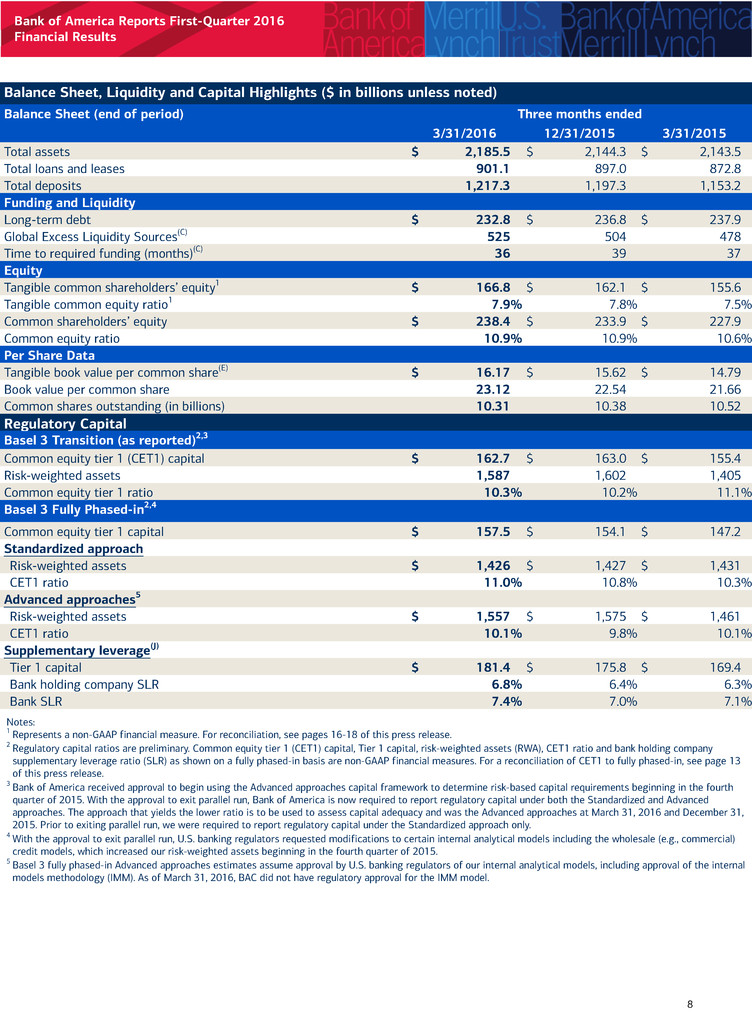
Bank of America Reports First-Quarter 2016 Financial Results 8 Balance Sheet, Liquidity and Capital Highlights ($ in billions unless noted) Balance Sheet (end of period) Three months ended 3/31/2016 12/31/2015 3/31/2015 Total assets $ 2,185.5 $ 2,144.3 $ 2,143.5 Total loans and leases 901.1 897.0 872.8 Total deposits 1,217.3 1,197.3 1,153.2 Funding and Liquidity Long-term debt $ 232.8 $ 236.8 $ 237.9 Global Excess Liquidity Sources(C) 525 504 478 Time to required funding (months)(C) 36 39 37 Equity Tangible common shareholders’ equity1 $ 166.8 $ 162.1 $ 155.6 Tangible common equity ratio1 7.9% 7.8% 7.5% Common shareholders’ equity $ 238.4 $ 233.9 $ 227.9 Common equity ratio 10.9% 10.9% 10.6% Per Share Data Tangible book value per common share(E) $ 16.17 $ 15.62 $ 14.79 Book value per common share 23.12 22.54 21.66 Common shares outstanding (in billions) 10.31 10.38 10.52 Regulatory Capital Basel 3 Transition (as reported)2,3 Common equity tier 1 (CET1) capital $ 162.7 $ 163.0 $ 155.4 Risk-weighted assets 1,587 1,602 1,405 Common equity tier 1 ratio 10.3% 10.2% 11.1% Basel 3 Fully Phased-in2,4 Common equity tier 1 capital $ 157.5 $ 154.1 $ 147.2 Standardized approach Risk-weighted assets $ 1,426 $ 1,427 $ 1,431 CET1 ratio 11.0% 10.8% 10.3% Advanced approaches5 Risk-weighted assets $ 1,557 $ 1,575 $ 1,461 CET1 ratio 10.1% 9.8% 10.1% Supplementary leverage(J) Tier 1 capital $ 181.4 $ 175.8 $ 169.4 Bank holding company SLR 6.8% 6.4% 6.3% Bank SLR 7.4% 7.0% 7.1% Notes: 1 Represents a non-GAAP financial measure. For reconciliation, see pages 16-18 of this press release. 2 Regulatory capital ratios are preliminary. Common equity tier 1 (CET1) capital, Tier 1 capital, risk-weighted assets (RWA), CET1 ratio and bank holding company supplementary leverage ratio (SLR) as shown on a fully phased-in basis are non-GAAP financial measures. For a reconciliation of CET1 to fully phased-in, see page 13 of this press release. 3 Bank of America received approval to begin using the Advanced approaches capital framework to determine risk-based capital requirements beginning in the fourth quarter of 2015. With the approval to exit parallel run, Bank of America is now required to report regulatory capital under both the Standardized and Advanced approaches. The approach that yields the lower ratio is to be used to assess capital adequacy and was the Advanced approaches at March 31, 2016 and December 31, 2015. Prior to exiting parallel run, we were required to report regulatory capital under the Standardized approach only. 4 With the approval to exit parallel run, U.S. banking regulators requested modifications to certain internal analytical models including the wholesale (e.g., commercial) credit models, which increased our risk-weighted assets beginning in the fourth quarter of 2015. 5 Basel 3 fully phased-in Advanced approaches estimates assume approval by U.S. banking regulators of our internal analytical models, including approval of the internal models methodology (IMM). As of March 31, 2016, BAC did not have regulatory approval for the IMM model.
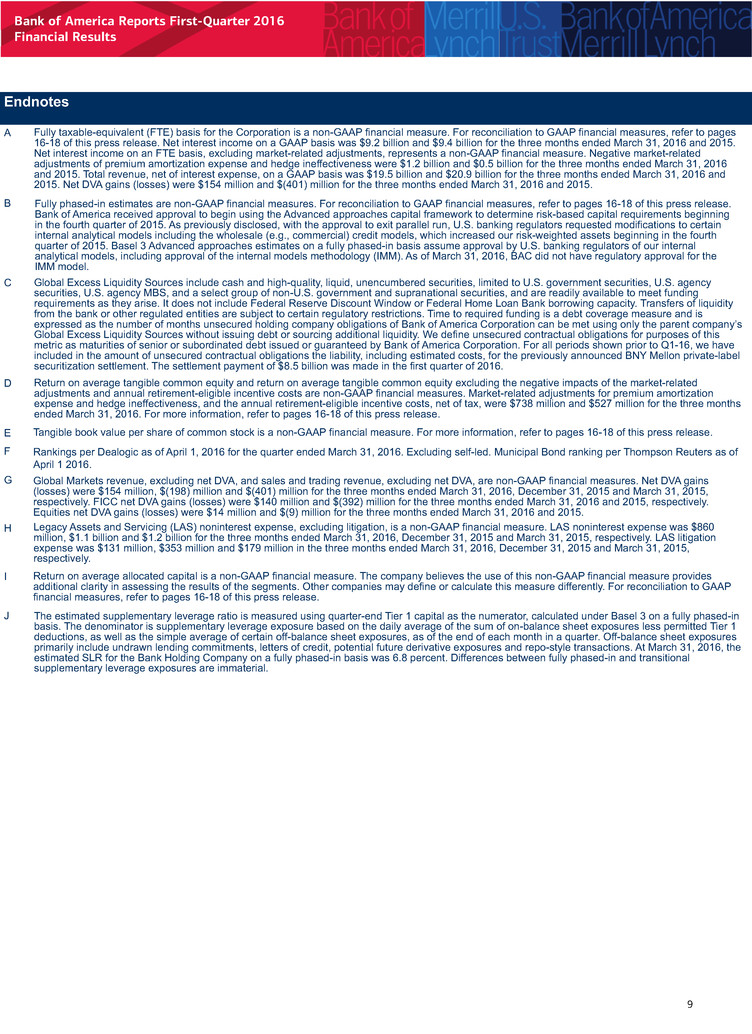
Bank of America Reports First-Quarter 2016 Financial Results 9 Endnotes A B C D E F G H I J Fully taxable-equivalent (FTE) basis for the Corporation is a non-GAAP financial measure. For reconciliation to GAAP financial measures, refer to pages 16-18 of this press release. Net interest income on a GAAP basis was $9.2 billion and $9.4 billion for the three months ended March 31, 2016 and 2015. Net interest income on an FTE basis, excluding market-related adjustments, represents a non-GAAP financial measure. Negative market-related adjustments of premium amortization expense and hedge ineffectiveness were $1.2 billion and $0.5 billion for the three months ended March 31, 2016 and 2015. Total revenue, net of interest expense, on a GAAP basis was $19.5 billion and $20.9 billion for the three months ended March 31, 2016 and 2015. Net DVA gains (losses) were $154 million and $(401) million for the three months ended March 31, 2016 and 2015. Fully phased-in estimates are non-GAAP financial measures. For reconciliation to GAAP financial measures, refer to pages 16-18 of this press release. Bank of America received approval to begin using the Advanced approaches capital framework to determine risk-based capital requirements beginning in the fourth quarter of 2015. As previously disclosed, with the approval to exit parallel run, U.S. banking regulators requested modifications to certain internal analytical models including the wholesale (e.g., commercial) credit models, which increased our risk-weighted assets beginning in the fourth quarter of 2015. Basel 3 Advanced approaches estimates on a fully phased-in basis assume approval by U.S. banking regulators of our internal analytical models, including approval of the internal models methodology (IMM). As of March 31, 2016, BAC did not have regulatory approval for the IMM model. Global Excess Liquidity Sources include cash and high-quality, liquid, unencumbered securities, limited to U.S. government securities, U.S. agency securities, U.S. agency MBS, and a select group of non-U.S. government and supranational securities, and are readily available to meet funding requirements as they arise. It does not include Federal Reserve Discount Window or Federal Home Loan Bank borrowing capacity. Transfers of liquidity from the bank or other regulated entities are subject to certain regulatory restrictions. Time to required funding is a debt coverage measure and is expressed as the number of months unsecured holding company obligations of Bank of America Corporation can be met using only the parent company’s Global Excess Liquidity Sources without issuing debt or sourcing additional liquidity. We define unsecured contractual obligations for purposes of this metric as maturities of senior or subordinated debt issued or guaranteed by Bank of America Corporation. For all periods shown prior to Q1-16, we have included in the amount of unsecured contractual obligations the liability, including estimated costs, for the previously announced BNY Mellon private-label securitization settlement. The settlement payment of $8.5 billion was made in the first quarter of 2016. Return on average tangible common equity and return on average tangible common equity excluding the negative impacts of the market-related adjustments and annual retirement-eligible incentive costs are non-GAAP financial measures. Market-related adjustments for premium amortization expense and hedge ineffectiveness, and the annual retirement-eligible incentive costs, net of tax, were $738 million and $527 million for the three months ended March 31, 2016. For more information, refer to pages 16-18 of this press release. Tangible book value per share of common stock is a non-GAAP financial measure. For more information, refer to pages 16-18 of this press release. Rankings per Dealogic as of April 1, 2016 for the quarter ended March 31, 2016. Excluding self-led. Municipal Bond ranking per Thompson Reuters as of April 1 2016. Legacy Assets and Servicing (LAS) noninterest expense, excluding litigation, is a non-GAAP financial measure. LAS noninterest expense was $860 million, $1.1 billion and $1.2 billion for the three months ended March 31, 2016, December 31, 2015 and March 31, 2015, respectively. LAS litigation expense was $131 million, $353 million and $179 million in the three months ended March 31, 2016, December 31, 2015 and March 31, 2015, respectively. Return on average allocated capital is a non-GAAP financial measure. The company believes the use of this non-GAAP financial measure provides additional clarity in assessing the results of the segments. Other companies may define or calculate this measure differently. For reconciliation to GAAP financial measures, refer to pages 16-18 of this press release. The estimated supplementary leverage ratio is measured using quarter-end Tier 1 capital as the numerator, calculated under Basel 3 on a fully phased-in basis. The denominator is supplementary leverage exposure based on the daily average of the sum of on-balance sheet exposures less permitted Tier 1 deductions, as well as the simple average of certain off-balance sheet exposures, as of the end of each month in a quarter. Off-balance sheet exposures primarily include undrawn lending commitments, letters of credit, potential future derivative exposures and repo-style transactions. At March 31, 2016, the estimated SLR for the Bank Holding Company on a fully phased-in basis was 6.8 percent. Differences between fully phased-in and transitional supplementary leverage exposures are immaterial. Global Markets revenue, excluding net DVA, and sales and trading revenue, excluding net DVA, are non-GAAP financial measures. Net DVA gains (losses) were $154 million, $(198) million and $(401) million for the three months ended March 31, 2016, December 31, 2015 and March 31, 2015, respectively. FICC net DVA gains (losses) were $140 million and $(392) million for the three months ended March 31, 2016 and 2015, respectively. Equities net DVA gains (losses) were $14 million and $(9) million for the three months ended March 31, 2016 and 2015.

Bank of America Reports First-Quarter 2016 Financial Results 10 Contact Information and Investor Conference Call Invitation Note: Chief Executive Officer Brian Moynihan and Chief Financial Officer Paul Donofrio will discuss first- quarter 2016 financial results in a conference call at 8:30 a.m. ET today. The presentation and supporting materials can be accessed on the Bank of America Investor Relations website at http://investor.bankofamerica.com. For a listen-only connection to the conference call, dial 1.877.200.4456 (U.S.) or 1.785.424.1732 (international), and the conference ID is: 79795. Please dial in 10 minutes prior to the start of the call. A replay will also be available beginning at noon ET on April 14 through midnight, April 21 by telephone at 1.800.753.8546 (U.S.) or 1.402.220.0685 (international). Investor Call Information Investors May Contact: Lee McEntire, Bank of America, 1.980.388.6780 Jonathan Blum, Bank of America (Fixed Income), 1.212.449.3112 Reporters May Contact: Jerry Dubrowski, Bank of America, 1.980.388.2840 jerome.f.dubrowski@bankofamerica.com About Bank of America Bank of America is one of the world's leading financial institutions, serving individual consumers, small and middle-market businesses and large corporations with a full range of banking, investing, asset management and other financial and risk management products and services. The company provides unmatched convenience in the United States, serving approximately 47 million consumer and small business relationships with approximately 4,700 retail financial centers, approximately 16,000 ATMs, and award-winning online banking with approximately 33 million active users and approximately 20 million mobile users. Bank of America is a global leader in wealth management, corporate and investment banking and trading across a broad range of asset classes, serving corporations, governments, institutions and individuals around the world. Bank of America offers industry-leading support to approximately 3 million small business owners through a suite of innovative, easy-to-use online products and services. The company serves clients through operations in all 50 states, the District of Columbia, the U.S. Virgin Islands, Puerto Rico and more than 35 countries. Bank of America Corporation stock (NYSE: BAC) is listed on the New York Stock Exchange. Forward-Looking Statements Bank of America and its management may make certain statements that constitute “forward-looking statements” within the meaning of the Private Securities Litigation Reform Act of 1995. These statements can be identified by the fact that they do not relate strictly to historical or current facts. Forward-looking statements often use words such as “anticipates,” “targets,” “expects,” “hopes,” “estimates,” “intends,” “plans,” “goals,” “believes,” “continue” and other similar expressions or future or conditional verbs such as “will,” “may,” “might,” “should,” “would” and “could.” Forward-looking statements represent Bank of America's current expectations, plans or forecasts of its future results and revenues, and future business and economic conditions more generally, and other future matters. These statements are not guarantees of future results or performance and involve certain known and unknown risks, uncertainties and assumptions that are difficult to predict and are often beyond Bank of America's control. Actual outcomes and results may differ materially from those expressed in, or implied by, any of these forward-looking statements.
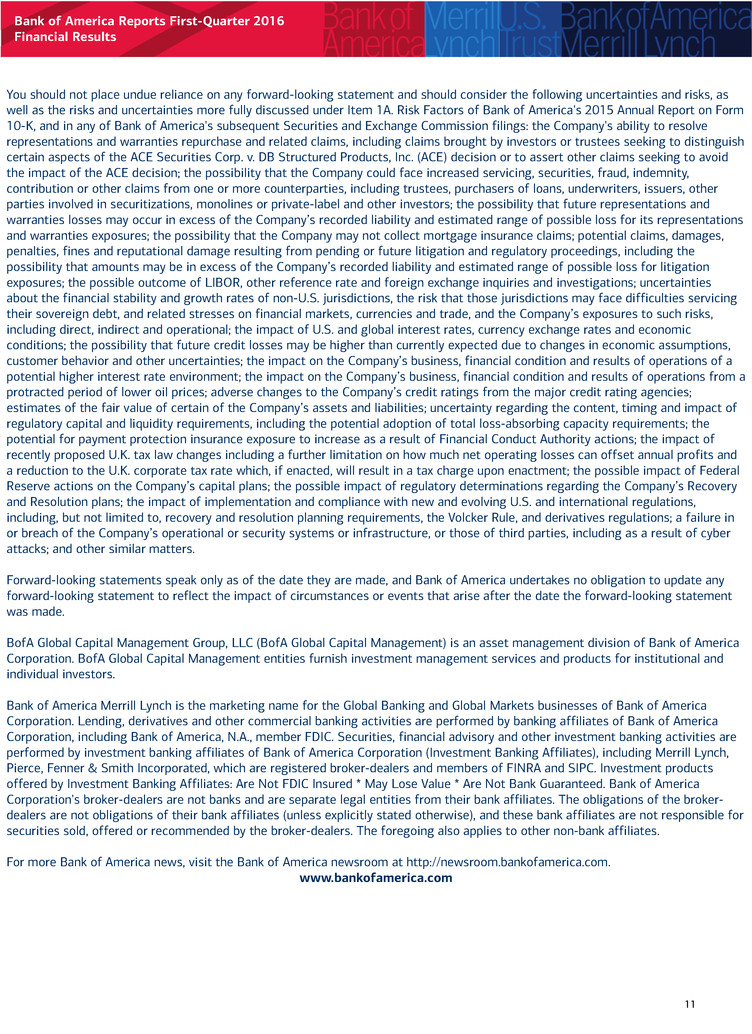
Bank of America Reports First-Quarter 2016 Financial Results 11 You should not place undue reliance on any forward-looking statement and should consider the following uncertainties and risks, as well as the risks and uncertainties more fully discussed under Item 1A. Risk Factors of Bank of America's 2015 Annual Report on Form 10-K, and in any of Bank of America's subsequent Securities and Exchange Commission filings: the Company's ability to resolve representations and warranties repurchase and related claims, including claims brought by investors or trustees seeking to distinguish certain aspects of the ACE Securities Corp. v. DB Structured Products, Inc. (ACE) decision or to assert other claims seeking to avoid the impact of the ACE decision; the possibility that the Company could face increased servicing, securities, fraud, indemnity, contribution or other claims from one or more counterparties, including trustees, purchasers of loans, underwriters, issuers, other parties involved in securitizations, monolines or private-label and other investors; the possibility that future representations and warranties losses may occur in excess of the Company’s recorded liability and estimated range of possible loss for its representations and warranties exposures; the possibility that the Company may not collect mortgage insurance claims; potential claims, damages, penalties, fines and reputational damage resulting from pending or future litigation and regulatory proceedings, including the possibility that amounts may be in excess of the Company’s recorded liability and estimated range of possible loss for litigation exposures; the possible outcome of LIBOR, other reference rate and foreign exchange inquiries and investigations; uncertainties about the financial stability and growth rates of non-U.S. jurisdictions, the risk that those jurisdictions may face difficulties servicing their sovereign debt, and related stresses on financial markets, currencies and trade, and the Company’s exposures to such risks, including direct, indirect and operational; the impact of U.S. and global interest rates, currency exchange rates and economic conditions; the possibility that future credit losses may be higher than currently expected due to changes in economic assumptions, customer behavior and other uncertainties; the impact on the Company’s business, financial condition and results of operations of a potential higher interest rate environment; the impact on the Company’s business, financial condition and results of operations from a protracted period of lower oil prices; adverse changes to the Company’s credit ratings from the major credit rating agencies; estimates of the fair value of certain of the Company’s assets and liabilities; uncertainty regarding the content, timing and impact of regulatory capital and liquidity requirements, including the potential adoption of total loss-absorbing capacity requirements; the potential for payment protection insurance exposure to increase as a result of Financial Conduct Authority actions; the impact of recently proposed U.K. tax law changes including a further limitation on how much net operating losses can offset annual profits and a reduction to the U.K. corporate tax rate which, if enacted, will result in a tax charge upon enactment; the possible impact of Federal Reserve actions on the Company’s capital plans; the possible impact of regulatory determinations regarding the Company’s Recovery and Resolution plans; the impact of implementation and compliance with new and evolving U.S. and international regulations, including, but not limited to, recovery and resolution planning requirements, the Volcker Rule, and derivatives regulations; a failure in or breach of the Company’s operational or security systems or infrastructure, or those of third parties, including as a result of cyber attacks; and other similar matters. Forward-looking statements speak only as of the date they are made, and Bank of America undertakes no obligation to update any forward-looking statement to reflect the impact of circumstances or events that arise after the date the forward-looking statement was made. BofA Global Capital Management Group, LLC (BofA Global Capital Management) is an asset management division of Bank of America Corporation. BofA Global Capital Management entities furnish investment management services and products for institutional and individual investors. Bank of America Merrill Lynch is the marketing name for the Global Banking and Global Markets businesses of Bank of America Corporation. Lending, derivatives and other commercial banking activities are performed by banking affiliates of Bank of America Corporation, including Bank of America, N.A., member FDIC. Securities, financial advisory and other investment banking activities are performed by investment banking affiliates of Bank of America Corporation (Investment Banking Affiliates), including Merrill Lynch, Pierce, Fenner & Smith Incorporated, which are registered broker-dealers and members of FINRA and SIPC. Investment products offered by Investment Banking Affiliates: Are Not FDIC Insured * May Lose Value * Are Not Bank Guaranteed. Bank of America Corporation's broker-dealers are not banks and are separate legal entities from their bank affiliates. The obligations of the broker- dealers are not obligations of their bank affiliates (unless explicitly stated otherwise), and these bank affiliates are not responsible for securities sold, offered or recommended by the broker-dealers. The foregoing also applies to other non-bank affiliates. For more Bank of America news, visit the Bank of America newsroom at http://newsroom.bankofamerica.com. www.bankofamerica.com

This information is preliminary and based on company data available at the time of the presentation. 12 Bank of America Corporation and Subsidiaries Selected Financial Data (Dollars in millions, except per share data; shares in thousands) Summary Income Statement First Quarter 2016 Fourth Quarter 2015 First Quarter 2015 Net interest income $ 9,171 $ 9,756 $ 9,411 Noninterest income 10,341 9,911 11,503 Total revenue, net of interest expense 19,512 19,667 20,914 Provision for credit losses 997 810 765 Noninterest expense 14,816 14,010 15,827 Income before income taxes 3,699 4,847 4,322 Income tax expense 1,019 1,511 1,225 Net income $ 2,680 $ 3,336 $ 3,097 Preferred stock dividends 457 330 382 Net income applicable to common shareholders $ 2,223 $ 3,006 $ 2,715 Common shares issued 4,936 71 3,859 Average common shares issued and outstanding 10,339,731 10,399,422 10,518,790 Average diluted common shares issued and outstanding 11,100,067 11,153,169 11,266,511 Summary Average Balance Sheet Total debt securities $ 399,809 $ 399,423 $ 383,120 Total loans and leases 892,984 886,156 867,169 Total earning assets 1,844,650 1,847,253 1,799,175 Total assets 2,173,618 2,180,472 2,138,574 Total deposits 1,198,455 1,186,051 1,130,726 Common shareholders’ equity 237,123 234,851 225,357 Total shareholders’ equity 260,317 257,125 245,744 Performance Ratios Return on average assets 0.50% 0.61% 0.59% Return on average tangible common shareholders’ equity (1) 5.41 7.32 7.19 Per common share information Earnings $ 0.21 $ 0.29 $ 0.26 Diluted earnings 0.21 0.28 0.25 Dividends paid 0.05 0.05 0.05 Book value 23.12 22.54 21.66 Tangible book value (1) 16.17 15.62 14.79 March 31 2016 December 31 2015 March 31 2015 Summary Period-End Balance Sheet Total debt securities $ 400,311 $ 407,005 $ 383,989 Total loans and leases 901,113 896,983 872,750 Total earning assets 1,861,868 1,805,980 1,795,590 Total assets 2,185,498 2,144,316 2,143,545 Total deposits 1,217,261 1,197,259 1,153,168 Common shareholders’ equity 238,434 233,932 227,915 Total shareholders’ equity 262,776 256,205 250,188 Common shares issued and outstanding 10,312,660 10,380,265 10,520,401 Credit Quality First Quarter 2016 Fourth Quarter 2015 First Quarter 2015 Total net charge-offs $ 1,068 $ 1,144 $ 1,194 Net charge-offs as a percentage of average loans and leases outstanding (2) 0.48% 0.52% 0.56% Provision for credit losses $ 997 $ 810 $ 765 March 31 2016 December 31 2015 March 31 2015 Total nonperforming loans, leases and foreclosed properties (3) $ 9,281 $ 9,836 $ 12,101 Nonperforming loans, leases and foreclosed properties as a percentage of total loans, leases and foreclosed properties (2) 1.04% 1.10% 1.40% Allowance for loan and lease losses $ 12,069 $ 12,234 $ 13,676 Allowance for loan and lease losses as a percentage of total loans and leases outstanding (2) 1.35% 1.37% 1.58% For footnotes see page 13.
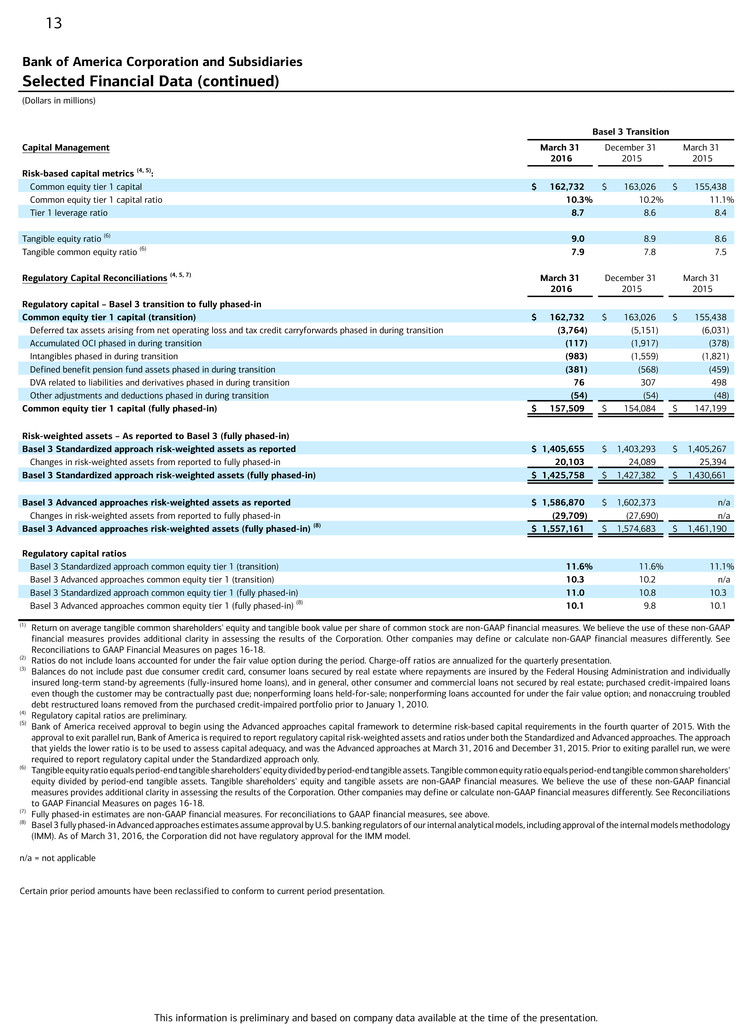
This information is preliminary and based on company data available at the time of the presentation. 13 Bank of America Corporation and Subsidiaries Selected Financial Data (continued) (Dollars in millions) Basel 3 Transition Capital Management March 31 2016 December 31 2015 March 31 2015 Risk-based capital metrics (4, 5): Common equity tier 1 capital $ 162,732 $ 163,026 $ 155,438 Common equity tier 1 capital ratio 10.3% 10.2% 11.1% Tier 1 leverage ratio 8.7 8.6 8.4 Tangible equity ratio (6) 9.0 8.9 8.6 Tangible common equity ratio (6) 7.9 7.8 7.5 Regulatory Capital Reconciliations (4, 5, 7) March 31 2016 December 31 2015 March 31 2015 Regulatory capital – Basel 3 transition to fully phased-in Common equity tier 1 capital (transition) $ 162,732 $ 163,026 $ 155,438 Deferred tax assets arising from net operating loss and tax credit carryforwards phased in during transition (3,764) (5,151) (6,031) Accumulated OCI phased in during transition (117) (1,917) (378) Intangibles phased in during transition (983) (1,559) (1,821) Defined benefit pension fund assets phased in during transition (381) (568) (459) DVA related to liabilities and derivatives phased in during transition 76 307 498 Other adjustments and deductions phased in during transition (54) (54) (48) Common equity tier 1 capital (fully phased-in) $ 157,509 $ 154,084 $ 147,199 Risk-weighted assets – As reported to Basel 3 (fully phased-in) Basel 3 Standardized approach risk-weighted assets as reported $ 1,405,655 $ 1,403,293 $ 1,405,267 Changes in risk-weighted assets from reported to fully phased-in 20,103 24,089 25,394 Basel 3 Standardized approach risk-weighted assets (fully phased-in) $ 1,425,758 $ 1,427,382 $ 1,430,661 Basel 3 Advanced approaches risk-weighted assets as reported $ 1,586,870 $ 1,602,373 n/a Changes in risk-weighted assets from reported to fully phased-in (29,709) (27,690) n/a Basel 3 Advanced approaches risk-weighted assets (fully phased-in) (8) $ 1,557,161 $ 1,574,683 $ 1,461,190 Regulatory capital ratios Basel 3 Standardized approach common equity tier 1 (transition) 11.6% 11.6% 11.1% Basel 3 Advanced approaches common equity tier 1 (transition) 10.3 10.2 n/a Basel 3 Standardized approach common equity tier 1 (fully phased-in) 11.0 10.8 10.3 Basel 3 Advanced approaches common equity tier 1 (fully phased-in) (8) 10.1 9.8 10.1 (1) Return on average tangible common shareholders' equity and tangible book value per share of common stock are non-GAAP financial measures. We believe the use of these non-GAAP financial measures provides additional clarity in assessing the results of the Corporation. Other companies may define or calculate non-GAAP financial measures differently. See Reconciliations to GAAP Financial Measures on pages 16-18. (2) Ratios do not include loans accounted for under the fair value option during the period. Charge-off ratios are annualized for the quarterly presentation. (3) Balances do not include past due consumer credit card, consumer loans secured by real estate where repayments are insured by the Federal Housing Administration and individually insured long-term stand-by agreements (fully-insured home loans), and in general, other consumer and commercial loans not secured by real estate; purchased credit-impaired loans even though the customer may be contractually past due; nonperforming loans held-for-sale; nonperforming loans accounted for under the fair value option; and nonaccruing troubled debt restructured loans removed from the purchased credit-impaired portfolio prior to January 1, 2010. (4) Regulatory capital ratios are preliminary. (5) Bank of America received approval to begin using the Advanced approaches capital framework to determine risk-based capital requirements in the fourth quarter of 2015. With the approval to exit parallel run, Bank of America is required to report regulatory capital risk-weighted assets and ratios under both the Standardized and Advanced approaches. The approach that yields the lower ratio is to be used to assess capital adequacy, and was the Advanced approaches at March 31, 2016 and December 31, 2015. Prior to exiting parallel run, we were required to report regulatory capital under the Standardized approach only. (6) Tangible equity ratio equals period-end tangible shareholders' equity divided by period-end tangible assets. Tangible common equity ratio equals period-end tangible common shareholders' equity divided by period-end tangible assets. Tangible shareholders' equity and tangible assets are non-GAAP financial measures. We believe the use of these non-GAAP financial measures provides additional clarity in assessing the results of the Corporation. Other companies may define or calculate non-GAAP financial measures differently. See Reconciliations to GAAP Financial Measures on pages 16-18. (7) Fully phased-in estimates are non-GAAP financial measures. For reconciliations to GAAP financial measures, see above. (8) Basel 3 fully phased-in Advanced approaches estimates assume approval by U.S. banking regulators of our internal analytical models, including approval of the internal models methodology (IMM). As of March 31, 2016, the Corporation did not have regulatory approval for the IMM model. n/a = not applicable Certain prior period amounts have been reclassified to conform to current period presentation.
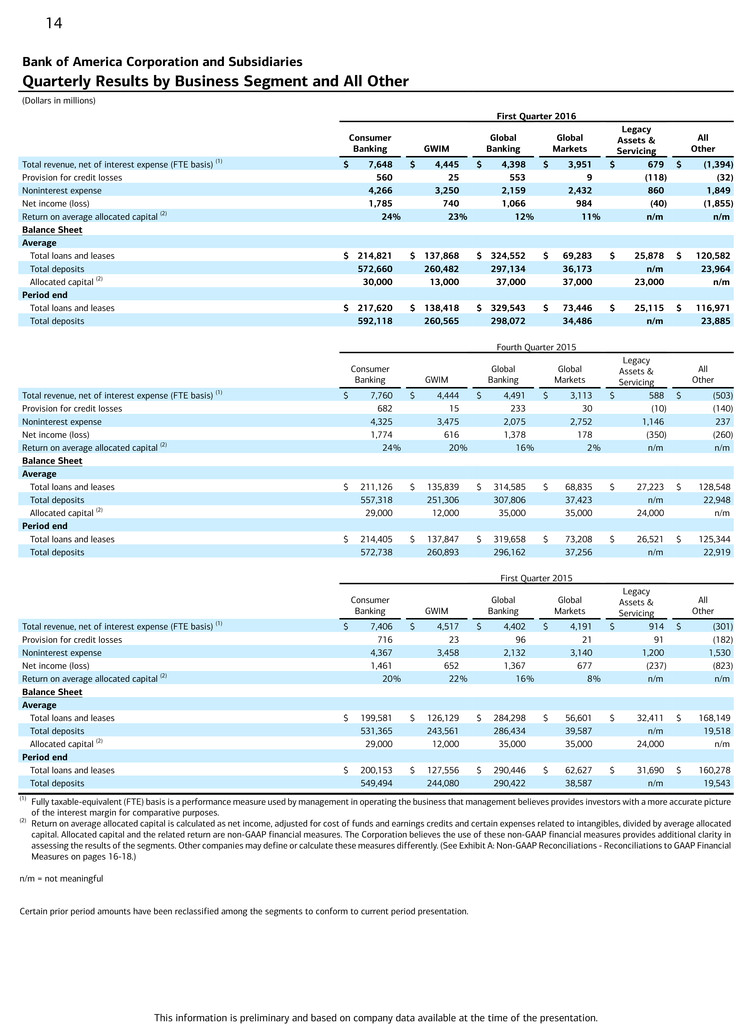
This information is preliminary and based on company data available at the time of the presentation. 14 Bank of America Corporation and Subsidiaries Quarterly Results by Business Segment and All Other (Dollars in millions) First Quarter 2016 Consumer Banking GWIM Global Banking Global Markets Legacy Assets & Servicing All Other Total revenue, net of interest expense (FTE basis) (1) $ 7,648 $ 4,445 $ 4,398 $ 3,951 $ 679 $ (1,394) Provision for credit losses 560 25 553 9 (118) (32) Noninterest expense 4,266 3,250 2,159 2,432 860 1,849 Net income (loss) 1,785 740 1,066 984 (40) (1,855) Return on average allocated capital (2) 24% 23% 12% 11% n/m n/m Balance Sheet Average Total loans and leases $ 214,821 $ 137,868 $ 324,552 $ 69,283 $ 25,878 $ 120,582 Total deposits 572,660 260,482 297,134 36,173 n/m 23,964 Allocated capital (2) 30,000 13,000 37,000 37,000 23,000 n/m Period end Total loans and leases $ 217,620 $ 138,418 $ 329,543 $ 73,446 $ 25,115 $ 116,971 Total deposits 592,118 260,565 298,072 34,486 n/m 23,885 Fourth Quarter 2015 Consumer Banking GWIM Global Banking Global Markets Legacy Assets & Servicing All Other Total revenue, net of interest expense (FTE basis) (1) $ 7,760 $ 4,444 $ 4,491 $ 3,113 $ 588 $ (503) Provision for credit losses 682 15 233 30 (10) (140) Noninterest expense 4,325 3,475 2,075 2,752 1,146 237 Net income (loss) 1,774 616 1,378 178 (350) (260) Return on average allocated capital (2) 24% 20% 16% 2% n/m n/m Balance Sheet Average Total loans and leases $ 211,126 $ 135,839 $ 314,585 $ 68,835 $ 27,223 $ 128,548 Total deposits 557,318 251,306 307,806 37,423 n/m 22,948 Allocated capital (2) 29,000 12,000 35,000 35,000 24,000 n/m Period end Total loans and leases $ 214,405 $ 137,847 $ 319,658 $ 73,208 $ 26,521 $ 125,344 Total deposits 572,738 260,893 296,162 37,256 n/m 22,919 First Quarter 2015 Consumer Banking GWIM Global Banking Global Markets Legacy Assets & Servicing All Other Total revenue, net of interest expense (FTE basis) (1) $ 7,406 $ 4,517 $ 4,402 $ 4,191 $ 914 $ (301) Provision for credit losses 716 23 96 21 91 (182) Noninterest expense 4,367 3,458 2,132 3,140 1,200 1,530 Net income (loss) 1,461 652 1,367 677 (237) (823) Return on average allocated capital (2) 20% 22% 16% 8% n/m n/m Balance Sheet Average Total loans and leases $ 199,581 $ 126,129 $ 284,298 $ 56,601 $ 32,411 $ 168,149 Total deposits 531,365 243,561 286,434 39,587 n/m 19,518 Allocated capital (2) 29,000 12,000 35,000 35,000 24,000 n/m Period end Total loans and leases $ 200,153 $ 127,556 $ 290,446 $ 62,627 $ 31,690 $ 160,278 Total deposits 549,494 244,080 290,422 38,587 n/m 19,543 (1) Fully taxable-equivalent (FTE) basis is a performance measure used by management in operating the business that management believes provides investors with a more accurate picture of the interest margin for comparative purposes. (2) Return on average allocated capital is calculated as net income, adjusted for cost of funds and earnings credits and certain expenses related to intangibles, divided by average allocated capital. Allocated capital and the related return are non-GAAP financial measures. The Corporation believes the use of these non-GAAP financial measures provides additional clarity in assessing the results of the segments. Other companies may define or calculate these measures differently. (See Exhibit A: Non-GAAP Reconciliations - Reconciliations to GAAP Financial Measures on pages 16-18.) n/m = not meaningful Certain prior period amounts have been reclassified among the segments to conform to current period presentation.
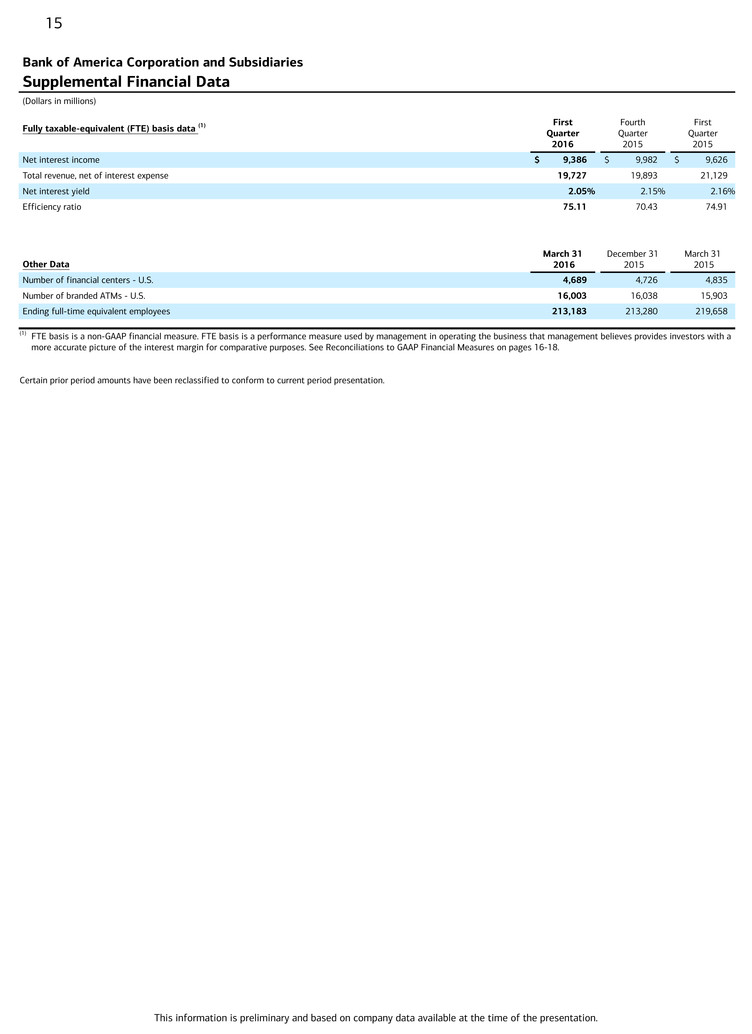
This information is preliminary and based on company data available at the time of the presentation. 15 Bank of America Corporation and Subsidiaries Supplemental Financial Data (Dollars in millions) Fully taxable-equivalent (FTE) basis data (1) FirstQuarter 2016 Fourth Quarter 2015 First Quarter 2015 Net interest income $ 9,386 $ 9,982 $ 9,626 Total revenue, net of interest expense 19,727 19,893 21,129 Net interest yield 2.05% 2.15% 2.16% Efficiency ratio 75.11 70.43 74.91 Other Data March 31 2016 December 31 2015 March 31 2015 Number of financial centers - U.S. 4,689 4,726 4,835 Number of branded ATMs - U.S. 16,003 16,038 15,903 Ending full-time equivalent employees 213,183 213,280 219,658 (1) FTE basis is a non-GAAP financial measure. FTE basis is a performance measure used by management in operating the business that management believes provides investors with a more accurate picture of the interest margin for comparative purposes. See Reconciliations to GAAP Financial Measures on pages 16-18. Certain prior period amounts have been reclassified to conform to current period presentation.
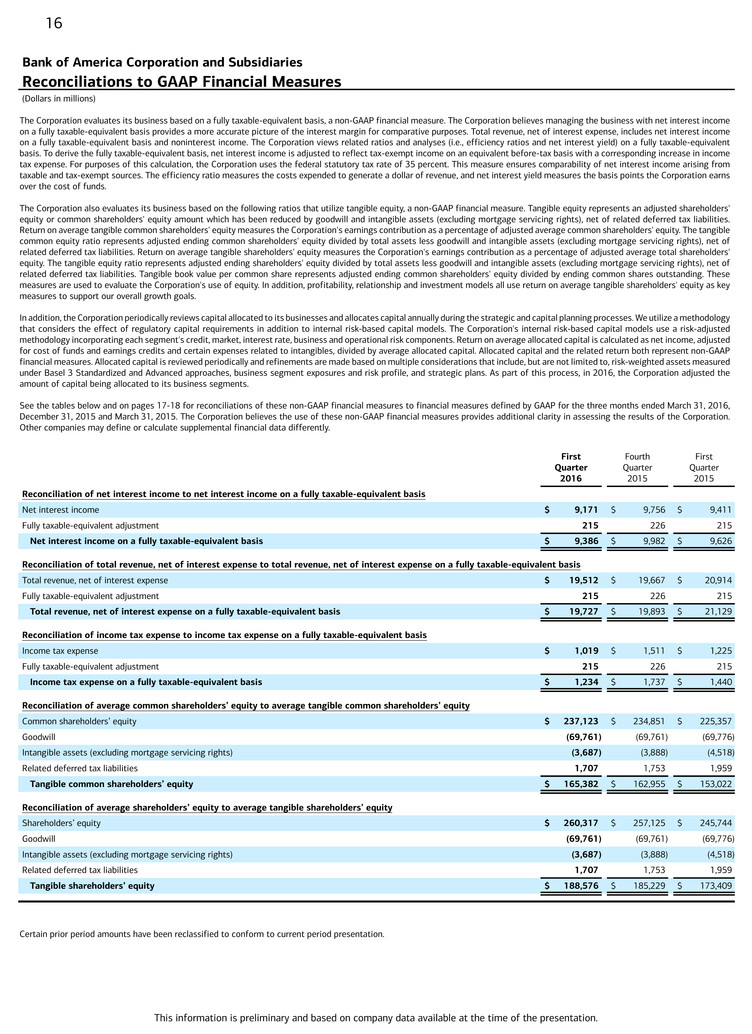
This information is preliminary and based on company data available at the time of the presentation. 16 Bank of America Corporation and Subsidiaries Reconciliations to GAAP Financial Measures (Dollars in millions) The Corporation evaluates its business based on a fully taxable-equivalent basis, a non-GAAP financial measure. The Corporation believes managing the business with net interest income on a fully taxable-equivalent basis provides a more accurate picture of the interest margin for comparative purposes. Total revenue, net of interest expense, includes net interest income on a fully taxable-equivalent basis and noninterest income. The Corporation views related ratios and analyses (i.e., efficiency ratios and net interest yield) on a fully taxable-equivalent basis. To derive the fully taxable-equivalent basis, net interest income is adjusted to reflect tax-exempt income on an equivalent before-tax basis with a corresponding increase in income tax expense. For purposes of this calculation, the Corporation uses the federal statutory tax rate of 35 percent. This measure ensures comparability of net interest income arising from taxable and tax-exempt sources. The efficiency ratio measures the costs expended to generate a dollar of revenue, and net interest yield measures the basis points the Corporation earns over the cost of funds. The Corporation also evaluates its business based on the following ratios that utilize tangible equity, a non-GAAP financial measure. Tangible equity represents an adjusted shareholders' equity or common shareholders' equity amount which has been reduced by goodwill and intangible assets (excluding mortgage servicing rights), net of related deferred tax liabilities. Return on average tangible common shareholders' equity measures the Corporation's earnings contribution as a percentage of adjusted average common shareholders' equity. The tangible common equity ratio represents adjusted ending common shareholders' equity divided by total assets less goodwill and intangible assets (excluding mortgage servicing rights), net of related deferred tax liabilities. Return on average tangible shareholders' equity measures the Corporation's earnings contribution as a percentage of adjusted average total shareholders' equity. The tangible equity ratio represents adjusted ending shareholders' equity divided by total assets less goodwill and intangible assets (excluding mortgage servicing rights), net of related deferred tax liabilities. Tangible book value per common share represents adjusted ending common shareholders' equity divided by ending common shares outstanding. These measures are used to evaluate the Corporation's use of equity. In addition, profitability, relationship and investment models all use return on average tangible shareholders' equity as key measures to support our overall growth goals. In addition, the Corporation periodically reviews capital allocated to its businesses and allocates capital annually during the strategic and capital planning processes. We utilize a methodology that considers the effect of regulatory capital requirements in addition to internal risk-based capital models. The Corporation's internal risk-based capital models use a risk-adjusted methodology incorporating each segment's credit, market, interest rate, business and operational risk components. Return on average allocated capital is calculated as net income, adjusted for cost of funds and earnings credits and certain expenses related to intangibles, divided by average allocated capital. Allocated capital and the related return both represent non-GAAP financial measures. Allocated capital is reviewed periodically and refinements are made based on multiple considerations that include, but are not limited to, risk-weighted assets measured under Basel 3 Standardized and Advanced approaches, business segment exposures and risk profile, and strategic plans. As part of this process, in 2016, the Corporation adjusted the amount of capital being allocated to its business segments. See the tables below and on pages 17-18 for reconciliations of these non-GAAP financial measures to financial measures defined by GAAP for the three months ended March 31, 2016, December 31, 2015 and March 31, 2015. The Corporation believes the use of these non-GAAP financial measures provides additional clarity in assessing the results of the Corporation. Other companies may define or calculate supplemental financial data differently. First Quarter 2016 Fourth Quarter 2015 First Quarter 2015 Reconciliation of net interest income to net interest income on a fully taxable-equivalent basis Net interest income $ 9,171 $ 9,756 $ 9,411 Fully taxable-equivalent adjustment 215 226 215 Net interest income on a fully taxable-equivalent basis $ 9,386 $ 9,982 $ 9,626 Reconciliation of total revenue, net of interest expense to total revenue, net of interest expense on a fully taxable-equivalent basis Total revenue, net of interest expense $ 19,512 $ 19,667 $ 20,914 Fully taxable-equivalent adjustment 215 226 215 Total revenue, net of interest expense on a fully taxable-equivalent basis $ 19,727 $ 19,893 $ 21,129 Reconciliation of income tax expense to income tax expense on a fully taxable-equivalent basis Income tax expense $ 1,019 $ 1,511 $ 1,225 Fully taxable-equivalent adjustment 215 226 215 Income tax expense on a fully taxable-equivalent basis $ 1,234 $ 1,737 $ 1,440 Reconciliation of average common shareholders’ equity to average tangible common shareholders’ equity Common shareholders’ equity $ 237,123 $ 234,851 $ 225,357 Goodwill (69,761) (69,761) (69,776) Intangible assets (excluding mortgage servicing rights) (3,687) (3,888) (4,518) Related deferred tax liabilities 1,707 1,753 1,959 Tangible common shareholders’ equity $ 165,382 $ 162,955 $ 153,022 Reconciliation of average shareholders’ equity to average tangible shareholders’ equity Shareholders’ equity $ 260,317 $ 257,125 $ 245,744 Goodwill (69,761) (69,761) (69,776) Intangible assets (excluding mortgage servicing rights) (3,687) (3,888) (4,518) Related deferred tax liabilities 1,707 1,753 1,959 Tangible shareholders’ equity $ 188,576 $ 185,229 $ 173,409 Certain prior period amounts have been reclassified to conform to current period presentation.
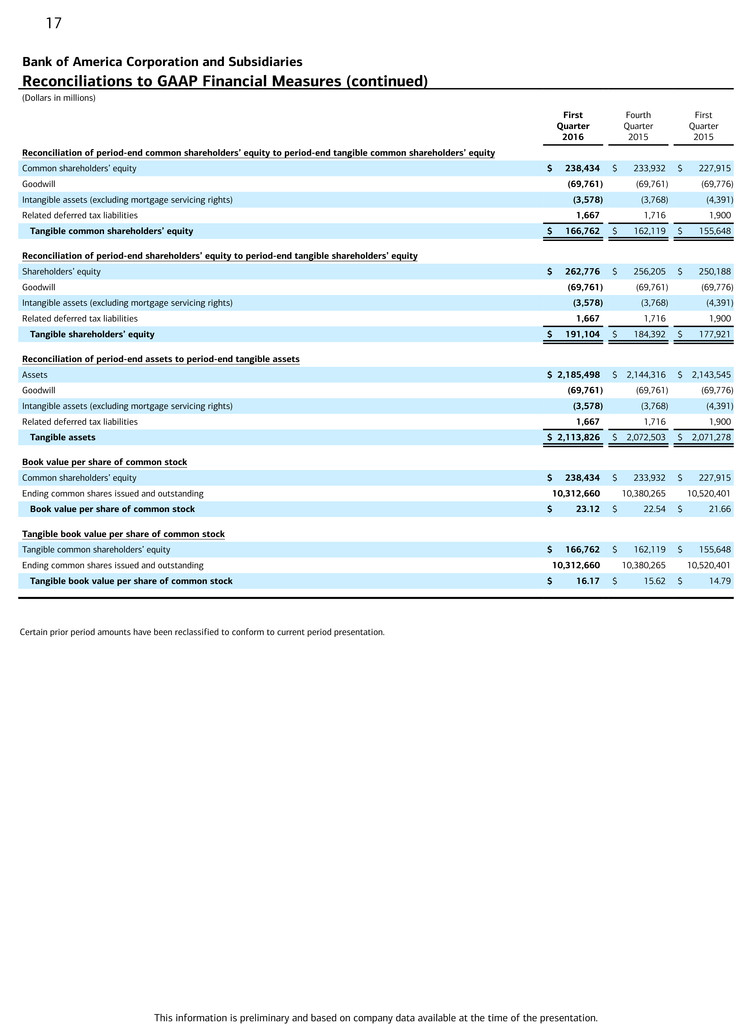
This information is preliminary and based on company data available at the time of the presentation. 17 Bank of America Corporation and Subsidiaries Reconciliations to GAAP Financial Measures (continued) (Dollars in millions) First Quarter 2016 Fourth Quarter 2015 First Quarter 2015 Reconciliation of period-end common shareholders’ equity to period-end tangible common shareholders’ equity Common shareholders’ equity $ 238,434 $ 233,932 $ 227,915 Goodwill (69,761) (69,761) (69,776) Intangible assets (excluding mortgage servicing rights) (3,578) (3,768) (4,391) Related deferred tax liabilities 1,667 1,716 1,900 Tangible common shareholders’ equity $ 166,762 $ 162,119 $ 155,648 Reconciliation of period-end shareholders’ equity to period-end tangible shareholders’ equity Shareholders’ equity $ 262,776 $ 256,205 $ 250,188 Goodwill (69,761) (69,761) (69,776) Intangible assets (excluding mortgage servicing rights) (3,578) (3,768) (4,391) Related deferred tax liabilities 1,667 1,716 1,900 Tangible shareholders’ equity $ 191,104 $ 184,392 $ 177,921 Reconciliation of period-end assets to period-end tangible assets Assets $ 2,185,498 $ 2,144,316 $ 2,143,545 Goodwill (69,761) (69,761) (69,776) Intangible assets (excluding mortgage servicing rights) (3,578) (3,768) (4,391) Related deferred tax liabilities 1,667 1,716 1,900 Tangible assets $ 2,113,826 $ 2,072,503 $ 2,071,278 Book value per share of common stock Common shareholders’ equity $ 238,434 $ 233,932 $ 227,915 Ending common shares issued and outstanding 10,312,660 10,380,265 10,520,401 Book value per share of common stock $ 23.12 $ 22.54 $ 21.66 Tangible book value per share of common stock Tangible common shareholders’ equity $ 166,762 $ 162,119 $ 155,648 Ending common shares issued and outstanding 10,312,660 10,380,265 10,520,401 Tangible book value per share of common stock $ 16.17 $ 15.62 $ 14.79 Certain prior period amounts have been reclassified to conform to current period presentation.

This information is preliminary and based on company data available at the time of the presentation. 18 Bank of America Corporation and Subsidiaries Reconciliations to GAAP Financial Measures (continued) (Dollars in millions) First Quarter 2016 Fourth Quarter 2015 First Quarter 2015 Reconciliation of return on average allocated capital (1) Consumer Banking Reported net income $ 1,785 $ 1,774 $ 1,461 Adjustment related to intangibles (2) 1 1 1 Adjusted net income $ 1,786 $ 1,775 $ 1,462 Average allocated equity (3) $ 60,261 $ 59,234 $ 59,295 Adjustment related to goodwill and a percentage of intangibles (30,261) (30,234) (30,295) Average allocated capital $ 30,000 $ 29,000 $ 29,000 Global Wealth & Investment Management Reported net income $ 740 $ 616 $ 652 Adjustment related to intangibles (2) 3 3 3 Adjusted net income $ 743 $ 619 $ 655 Average allocated equity (3) $ 23,098 $ 22,115 $ 22,168 Adjustment related to goodwill and a percentage of intangibles (10,098) (10,115) (10,168) Average allocated capital $ 13,000 $ 12,000 $ 12,000 Global Banking Reported net income $ 1,066 $ 1,378 $ 1,367 Adjustment related to intangibles (2) — — — Adjusted net income $ 1,066 $ 1,378 $ 1,367 Average allocated equity (3) $ 60,937 $ 58,938 $ 58,877 Adjustment related to goodwill and a percentage of intangibles (23,937) (23,938) (23,877) Average allocated capital $ 37,000 $ 35,000 $ 35,000 Global Markets Reported net income $ 984 $ 178 $ 677 Adjustment related to intangibles (2) 2 2 2 Adjusted net income $ 986 $ 180 $ 679 Average allocated equity (3) $ 42,332 $ 40,338 $ 40,416 Adjustment related to goodwill and a percentage of intangibles (5,332) (5,338) (5,416) Average allocated capital $ 37,000 $ 35,000 $ 35,000 (1) There are no adjustments to reported net income (loss) or average allocated equity for Legacy Assets & Servicing. (2) Represents cost of funds, earnings credits and certain expenses related to intangibles. (3) Average allocated equity is comprised of average allocated capital plus capital for the portion of goodwill and intangibles specifically assigned to the business segment. Certain prior period amounts have been reclassified to conform to current period presentation.

















